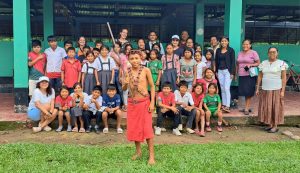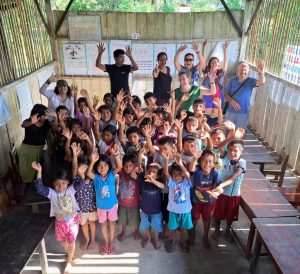In December 2023, we learned on-site about the pilot implementation of the common approach of Child Centered Social Accountability (CCSA) with cultural adaptation to indigenous populations in three communities in the Peruvian Amazon, the implementation of which was led by Action for Children y EQUITY Peruwho complemented the approach and adaptation of this methodology.
EQUIDAD Peru has extensive experience working with the Awajún people in various communities, and Acción por los Niños has piloted the common approach at the global level with Save the Children, providing advice from its experience in implementing the common approach in a district of the capital of Peru, and also its vision of civil society organizations in the global presentation of the common approach.

Save the Children’s offices in Peru and Guatemala joined this visit to learn about the implementation of the common approach and the opportunity to implement it in the context of indigenous communities.
According to Action for Children[1]The social accountability approach is based on the right of citizens, especially children, to evaluate the quality of public services and hold providers accountable, thus ensuring that services meet their needs and expectations.
In order to exercise social responsibility, it is essential that children and adolescents know their rights and recognize themselves as users with the right to receive quality care; that service providers have a receptive attitude and assume their functions responsibly; and that a mechanism is generated that allows for an honest and transparent dialogue on the quality of service provision and agreements to achieve the necessary improvements.
This approach complements, with the participation of children and adolescents, the supervision and control mechanisms that the public administration and the State are obliged to establish to guarantee access to and quality of public services.

Having this conceptual and methodological framework developed globally, the challenge this time has been to implement it not only in rural environments, but also with indigenous peoples, in this case the Awajún people. This pilot adaptation experience began in August 2023, so the first limitation has been time, since the pilot was to be completed in December 2023. In general, it is recommended to have at least 12 months to optimally develop the methodology. Nevertheless, EQUIDAD Peru, given its work in this territory, will continue to follow up on the activities and processes initiated by the children.
A first key action that has led to the positive implementation of the methodology was the alliance with the Awajún Autonomous Territorial Government. This indigenous governance space, with a strong leadership that is committed to the necessary changes that promote the progress of the Awajún people, has been essential for the territorial and community level to give a green light and a friendly entrance to the intervention communities. For this purpose, several meetings were held with the leaders to share the project’s objective, its purpose, the presentation of the methodology and the needs to be able to carry it out. These meetings were very well received and aimed at a mutual understanding of needs, objectives and expectations, which resulted in the identification of the three intervention communities and also in a first approximation of the work with children and adolescents, as well as with community leaders and the community in general.
Thus, together with the Awajún Autonomous Territorial Government, three promoters were selected (two women and one man), one per community, who could support the implementation and follow-up of the project, as well as act as a bridge with the community leaders (Pamuk) and the autonomous territorial government itself. These promoters also had to meet some basic requirements such as availability of time, knowledge of the community and support, and motivation to carry out activities with children and adolescents.
Once the promoters were chosen and trained in the common approach, together with the team of Acción por los Niños and EQUIDAD Perú (who traveled once a month to the communities and had continuous communication and accompaniment with the promoters via telephone), the process of calling the communities was initiated so that children and adolescents could express their desire to participate, as well as that of their families.
Each community has its particularities, but in general, the following singularities were found to have an impact on the implementation:
In total, around 90 children and adolescents have participated in a sustained and protagonist way in the process, with different priority themes that they identified after different work sessions and methodological adaptation:
 During the implementation of this pilot experience, it has been possible to verify during the visit the development of two relevant actions that show the work process and also the achievement of the initial objectives proposed in the methodology:
During the implementation of this pilot experience, it has been possible to verify during the visit the development of two relevant actions that show the work process and also the achievement of the initial objectives proposed in the methodology:
Another achievement not initially expected from this pilot experience that could be seen during this visit was the installation of the first School Municipality in the community of Nazareth, with the support of the promoter in the community and also of the educational community. Undoubtedly a space for school governance that has been very well received by the school and also by the community and we hope that it can continue in the coming years.
[1] Action for Children, “Social responsibility focused on children. Una experiencia en desarrollo”, October 2021, Lima (Peru).
Save the children
We firmly believe that the internet should be available and accessible to anyone, and are committed to providing a website that is accessible to the widest possible audience, regardless of circumstance and ability.
To fulfill this, we aim to adhere as strictly as possible to the World Wide Web Consortium’s (W3C) Web Content Accessibility Guidelines 2.1 (WCAG 2.1) at the AA level. These guidelines explain how to make web content accessible to people with a wide array of disabilities. Complying with those guidelines helps us ensure that the website is accessible to all people: blind people, people with motor impairments, visual impairment, cognitive disabilities, and more.
This website utilizes various technologies that are meant to make it as accessible as possible at all times. We utilize an accessibility interface that allows persons with specific disabilities to adjust the website’s UI (user interface) and design it to their personal needs.
Additionally, the website utilizes an AI-based application that runs in the background and optimizes its accessibility level constantly. This application remediates the website’s HTML, adapts Its functionality and behavior for screen-readers used by the blind users, and for keyboard functions used by individuals with motor impairments.
If you’ve found a malfunction or have ideas for improvement, we’ll be happy to hear from you. You can reach out to the website’s operators by using the following email
Our website implements the ARIA attributes (Accessible Rich Internet Applications) technique, alongside various different behavioral changes, to ensure blind users visiting with screen-readers are able to read, comprehend, and enjoy the website’s functions. As soon as a user with a screen-reader enters your site, they immediately receive a prompt to enter the Screen-Reader Profile so they can browse and operate your site effectively. Here’s how our website covers some of the most important screen-reader requirements, alongside console screenshots of code examples:
Screen-reader optimization: we run a background process that learns the website’s components from top to bottom, to ensure ongoing compliance even when updating the website. In this process, we provide screen-readers with meaningful data using the ARIA set of attributes. For example, we provide accurate form labels; descriptions for actionable icons (social media icons, search icons, cart icons, etc.); validation guidance for form inputs; element roles such as buttons, menus, modal dialogues (popups), and others. Additionally, the background process scans all of the website’s images and provides an accurate and meaningful image-object-recognition-based description as an ALT (alternate text) tag for images that are not described. It will also extract texts that are embedded within the image, using an OCR (optical character recognition) technology. To turn on screen-reader adjustments at any time, users need only to press the Alt+1 keyboard combination. Screen-reader users also get automatic announcements to turn the Screen-reader mode on as soon as they enter the website.
These adjustments are compatible with all popular screen readers, including JAWS and NVDA.
Keyboard navigation optimization: The background process also adjusts the website’s HTML, and adds various behaviors using JavaScript code to make the website operable by the keyboard. This includes the ability to navigate the website using the Tab and Shift+Tab keys, operate dropdowns with the arrow keys, close them with Esc, trigger buttons and links using the Enter key, navigate between radio and checkbox elements using the arrow keys, and fill them in with the Spacebar or Enter key.Additionally, keyboard users will find quick-navigation and content-skip menus, available at any time by clicking Alt+1, or as the first elements of the site while navigating with the keyboard. The background process also handles triggered popups by moving the keyboard focus towards them as soon as they appear, and not allow the focus drift outside of it.
Users can also use shortcuts such as “M” (menus), “H” (headings), “F” (forms), “B” (buttons), and “G” (graphics) to jump to specific elements.
We aim to support the widest array of browsers and assistive technologies as possible, so our users can choose the best fitting tools for them, with as few limitations as possible. Therefore, we have worked very hard to be able to support all major systems that comprise over 95% of the user market share including Google Chrome, Mozilla Firefox, Apple Safari, Opera and Microsoft Edge, JAWS and NVDA (screen readers), both for Windows and for MAC users.
Despite our very best efforts to allow anybody to adjust the website to their needs, there may still be pages or sections that are not fully accessible, are in the process of becoming accessible, or are lacking an adequate technological solution to make them accessible. Still, we are continually improving our accessibility, adding, updating and improving its options and features, and developing and adopting new technologies. All this is meant to reach the optimal level of accessibility, following technological advancements. For any assistance, please reach out to















